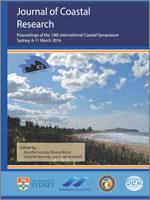Schwarzer, K.; Nguyen Cong Thanh and Ricklefs, K., 2016. Sediment re-deposition in the mangrove environment of Can Gio, Saigon River estuary (Vietnam). In: Vila-Concejo, A.; Bruce, E.; Kennedy, D.M., and McCarroll, R.J. (eds.), Proceedings of the 14th International Coastal Symposium (Sydney, Australia). Journal of Coastal Research, Special Issue, No. 75, pp. 138–142. Coconut Creek (Florida), ISSN 0749-0208.
Sediment re-deposition in mangrove environments is usually attributed to marine and estuarine hydrodynamics - rainfall as a driver was not considered yet. However, combined with annual water level variations, tropical rainfall can play a significant role for sediment re-deposition. Inside mangroves, current velocities induced by rainwater runoff during low tide conditions can be much stronger than tide-induced currents. Along the Saigon River Estuary and the Mekong Delta coastline, rainfall is high from May to October and low from December to April. To study processes controlling sediment re-deposition, data of current and suspended matter concentration have been combined with sediment re-deposition rates. All investigations have been carried out in the Can Gio mangrove reserve, Saigon River mouth. Based on a 19-year data set (1991 – 2009), strong annual variability in water level heights and tidal range are observed, with a mean maximum high tide level of 3.34 m during the rainy season and 3.73 m at the beginning of the dry season. Maximum tidal range is reached during the rainy season coinciding with the lowest annual average sea level. The highest parts of the mangrove forest are not inundated by tides during these periods. Only heavy rainfall during these times can lead to mangrove soil mobilisation, induce strong currents between the mangrove roots and cause erosional gullies. Depending on the amount of precipitation, this sediment mobilisation and the amount of suspension load in the forest can be much stronger than sediment transport induced by tidal currents.





